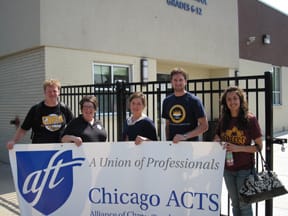 Two years ago, teachers at the Chicago Mathematics and Science Academy voted to form a union by card check. Photo from ACTS Michigan. |
(Updated January 17, 2013 for the Education Gadfly Weekly)
The National Alliance for Public Charter Schools should be careful what it wishes for. Although a recent case before the National Labor Relations Board was decided in the direction favored by the Alliance, by vacillating opportunistically on the issue of whether charters are public or private the organization has weakened the charter movement’s long game.
Here’s what happened: Two years back, teachers at the Chicago Mathematics and Science Academy voted to form a union via card check—a power granted to public employees under Illinois labor law. In response, the charter school asked the NLRB to intervene, arguing that it was a privately run institution, not a “political subdivision” of the state—and, therefore, that attempts to organize its employees should fall under federal law and be done by secret ballot.
In March 2011, the Alliance, led at the time by Peter Groff, filed a brief supporting the Academy’s position. Charter schools are indeed public schools, the Alliance reasoned, but they’re run by private entities. Hence their employees should be treated like other private-sector employees. “To impose state labor law obligations on private charter school employers, even in a public school setting, is inconsistent with the goal of differentiating these schools from ‘traditional’ public schools,” the Alliance argued.
And the NLRB agreed with that position, though it did so by invalidating an earlier ruling from the director of its Chicago region (akin to a “lower court”). In the overturned ruling, the NLRB regional director had determined that even though the government hired and fired no one at the Chicago Mathematics and Science Academy, the charter school was still a political subdivision with responsibilities to the public. “CMSA and its Board of Directors are subject to statutory restrictions, regulations, and privileges that a private employer would not be subject to,” the regional director said. Not the least of those privileges is public funding.
Interestingly—and confusingly—his position resembled that taken by the National Alliance on a separate matter involving pensions in February 2012. At that time, the Alliance objected to proposed IRS regulations forcing states to prohibit charter school teachers from participating in government retirement plans. In its statement on the draft pension regulations—which would have reversed previous IRS rulings that charters are state “instrumentalities”—the Alliance argued,
The evidence is clear: charter schools are public schools; the degree of state control over charter schools and public funding of such schools justify amending the Proposed Regulation such that public charter schools are considered agencies or instrumentalities of the state for purposes of the Internal Revenue Service’s ‘governmental plan’ definition; and to hold otherwise would harm more than 93% of our national public charter school workforce.
So are they public or are they private? You cannot argue that charter schools are not governmental subdivisions for purposes of escaping hostile state labor laws and sundry public regulations in one breath, and then urge the IRS to deem charters “agencies or instrumentalities of the state” so that their employees can continue to benefit from government retirement plans in the next.
Such inconsistency does no favor to charter schools—particularly when it comes to funding. The Alliance had endeavored for years—and with mounting success—to codify the proposition that charter schools are public schools and therefore deserve all the funding and access to facilities that one would expect public schools to have. Their public-ness is also vital to their constitutionality in a number of states. But how can they be public schools if it is also contended that they’re private entities?
To be sure, the NLRB decision was limited to the Chicago charter school. But by helping to convince the board that even one such school is not an “instrumentality of the state” and therefore should come under federal labor jurisdiction, the Alliance may have subjected other charters to federal labor laws and unionization they never before had to worry about, thereby playing right into the hands of teacher unions keen to organize the instructors in these new schools. Bad.
